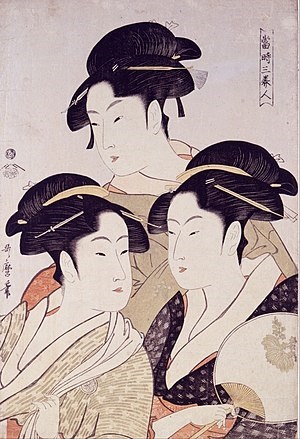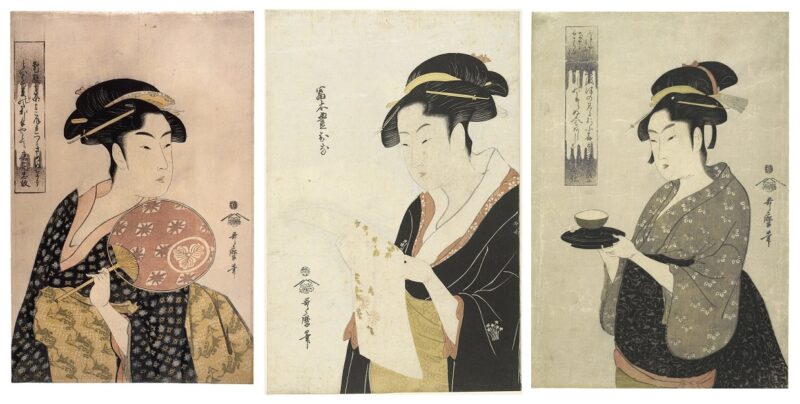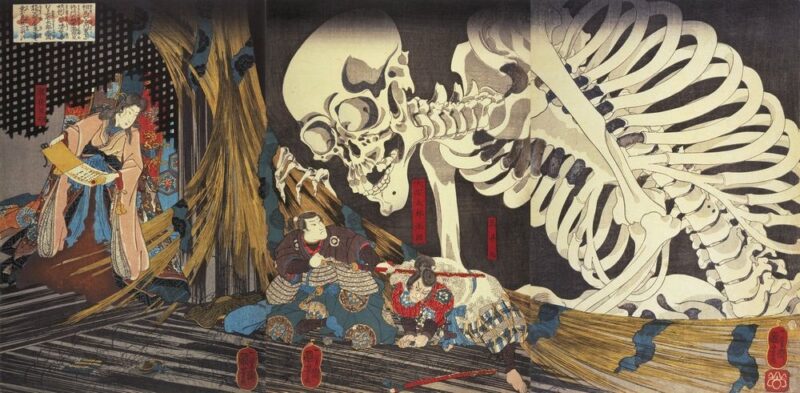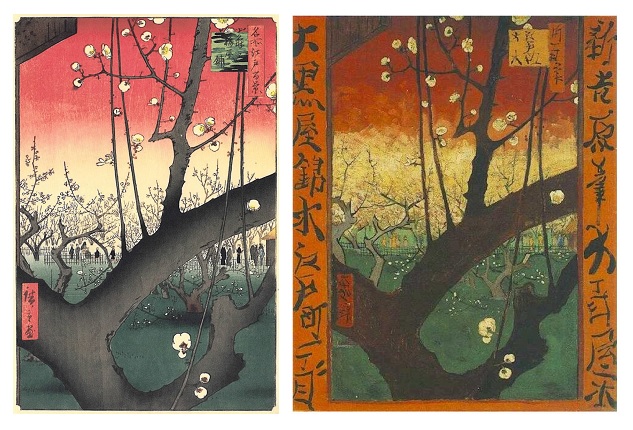If you're new to ukiyo-e and want to discover more of its unique beauty, this series is for you. In Part 2, we’ll continue exploring the remaining must-see masterpieces from our top 10 picks.
10 Masterpieces of Ukiyo-e: Celebrated Japanese Art Admired Worldwide

From the series Thirty-Six Views of Mount Fuji
Source: Tokyo Fuji Art Museum
Japanese landscapes and famous sights were popular themes in ukiyo-e, with Hokusai’s Thirty-Six Views of Mount Fuji and Hiroshige’s The Fifty-Three Stations of the Tōkaidō being especially iconic. These works gave people at the time the feeling of traveling through distant places—without ever leaving home.
In Part 1, we introduced the four main genres of ukiyo-e and explored why this art form is so highly valued around the world. If you haven’t read it yet, be sure to check it out!
▶10 Masterpieces of Ukiyo-e: What Makes Japanese Art Globally Acclaimed? (Part 1)
Now, let’s dive into Part 2 and discover the rest of the masterpieces!
6:Utagawa Hiroshige – “Sudden Shower over Shin-Ōhashi Bridge and Atake”

source: Tokyo Fuji Art Museum
From the series One Hundred Famous Views of Edo
Edo Period / c. 1857 (Ansei 4), ōban nishiki-e
Hiroshige produced a number of hit series featuring famous scenic spots across Japan, such as The Sixty-Nine Stations of the Kiso Kaidō and Eight Views of Ōmi. His final and perhaps greatest achievement came in the 1850s with the One Hundred Famous Views of Edo, a celebrated collection capturing the beauty of Edo (now Tokyo) through Hiroshige’s unique artistic lens.
One of the most iconic prints from this series is Sudden Shower over Shin-Ōhashi Bridge and Atake. It vividly depicts people crossing the Shin-Ōhashi Bridge over the Sumida River, caught in a sudden summer downpour. “Atake” refers to the area near the Ofunagura (a boat warehouse) on the opposite shore. The dramatic slanting lines of black rain and the vertical composition intensify the sense of a powerful storm. The distant buildings are blurred by rain, as if seen through a curtain of water. The tilted bridge and skewed horizon add a striking tension to the overall scene.
A fascinating detail is the dark raincloud at the top of the print, created using a highly skilled printing technique known as atenashi bokashi—a type of gradation applied by hand without any guide. This requires the printer to rely entirely on experience and intuition, making each print subtly different and truly one of a kind.
This work, along with Plum Estate, Kameido, was famously copied by Vincent van Gogh. Hiroshige’s One Hundred Famous Views of Edo became a key influence in the rise of Japonisme in 19th-century Europe, and left a lasting impact on Western art history.
7: Kitagawa Utamaro – Ten Types of Women’s Physiognomies: Young Woman Blowing a Popen
-1.jpg)
Source: Wikipedia
Edo period / c. 1792–93 (Kansei 4–5), ōban nishiki-e
Collection: The Metropolitan Museum of Art
On June 22, 2016, Kitagawa Utamaro’s bijinga (beautiful woman picture) Fukaku Shinobu Koi was sold at an auction in Paris for a record-breaking €745,000 (approx. 88 million yen)—the highest price ever paid for a woodblock ukiyo-e print. The news brought renewed attention to Utamaro’s global recognition and the exceptional value of his work.
Utamaro was an ukiyo-e artist who flourished in the Kansei era (1789–1801), during the late Edo period. He was celebrated as the leading master of bijinga, and his popularity sometimes even rivaled that of Katsushika Hokusai. One of Utamaro’s most iconic works is Young Woman Blowing a Popen. This print is so well known that it often appears in history textbooks and may look familiar even to those not well-versed in ukiyo-e.
The “popen” in the title refers to a traditional Japanese toy made of glass. It’s a small flask-shaped instrument that makes a popping sound—pekon pekon—when blown into, thanks to a thin glass membrane at its base. In this print, the young woman has the toy delicately held in her mouth, making it a striking focal point.
The subject is believed to be a 14- or 15-year-old unmarried town girl from a wealthy family. One clue lies in her hairstyle. She wears a “musume-shimada” coiffure, which was popular among young, unmarried women in late Edo society. In bijinga, the faces of women often look similar, but hairstyles can offer hints about their social status and age group.
Utamaro also frequently used a printing technique called kirazuri—mica printing—to enhance the texture and elegance of clothing and backgrounds. While Tōshūsai Sharaku favored black mica printing, Utamaro was known for using white mica printing (shiro-kirazuri). If you view a well-preserved print from different angles, you can see the white mica sparkle subtly across the surface.
This shimmering effect showcases the refined craftsmanship of Edo-period printers. So if you ever get the chance to view one of Utamaro’s prints in person, be sure to tilt it and watch it glimmer—it’s like seeing a touch of Edo magic.
8:Kitagawa Utamaro – Three Beauties of the Kansei Era

Source: Wikipedia
Edo Period / c. 1793 (Kansei 5) – Ōban Nishiki-e
Collection: Musée Guimet, Paris
In the Edo period, the ultimate celebrities were kabuki actors and high-ranking courtesans of Yoshiwara. However, these figures were far removed from the daily lives of ordinary people—distant icons rather than approachable idols.
As the Edo period progressed, however, the focus of bijin-ga (pictures of beautiful women) shifted. Instead of unreachable stars, artists began to depict real-life women working at local shops, such as rice cracker sellers and tea shop attendants. These women became the Edo-era version of "idols you can actually meet"—much like Japan’s modern AKB48. Utamaro's Three Beauties of the Kansei Era is a prime example of this new trend.
This artwork features the top three beauties of Edo at the time, known collectively as the “Three Beauties of the Kansei Era.” They were real women whose names and even ages are known today:
- Ohisa (17, left) – A popular shopgirl at Takashimaya, a rice cracker shop in Ryōgoku-Yagenbori
- Okita (16, right) – A beloved waitress at Naniwaya, a tea house in Asakusa
- Toyohina (center/top) – A geisha and certified performer of the Tomimoto school of music
(Her exact age is unknown, but she is believed to have been older than Ohisa and Okita.)

A striking feature of this piece is Utamaro's use of the ōkubi-e (large-headed portrait) style to create a dynamic group portrait that fills the entire frame. This bold composition became one of Utamaro’s signature styles and is considered a hallmark of his work.
9: Utagawa Kuniyoshi – The Haunted Old Palace at Sōma

Source: Wikipedia
Edo Period / Kōka 2–3 (1845–46)
This print, The Haunted Old Palace at Sōma (Sōma no Furudairi), is one of Utagawa Kuniyoshi’s most iconic masterpieces. Its most striking feature is the enormous skeleton depicted on the right side of the composition—a figure so impactful that it has graced the cover of major ukiyo-e exhibitions.
The term furudairi refers to the ruins of the palace built by Taira no Masakado in Shimōsa Province. In this scene, the setting is that very ruin, where the brave warrior Ōya Tarō Mitsukuni confronts Princess Takiyasha, the sorceress daughter of Masakado. The giant skeleton is, in fact, a creature summoned through her dark magic.
Take a closer look at the left side of the image, and you’ll see Takiyasha-hime holding a scroll as she casts her spell—raising the monstrous skeleton to confront the hero. It’s a dramatic moment full of supernatural tension and visual intrigue.
What truly stands out is the anatomical precision of the skeleton. It’s said that Kuniyoshi studied Western anatomical diagrams and incorporated this knowledge into his art, lending this piece an extraordinary level of realism. And yet, despite the eerie subject matter, the scene has a humorous and theatrical tone rather than one of pure horror. This blend of the grotesque and the playful is one of Kuniyoshi’s signature traits—and part of what makes his work so captivating.
Interestingly, Kuniyoshi’s path to success wasn’t easy. Though he debuted as a print artist at the age of 18, he struggled for over a decade before rising to fame, initially overshadowed by his fellow Utagawa school artist, Kunisada.
10: Utagawa Hiroshige – “Plum Estate, Kameido” from One Hundred Famous Views of Edo

Source: Tokyo Fuji Art Museum
Edo period / Ansei 4 (1857), November
Ōban Nishiki-e (large-format color woodblock print)
The final piece in this selection is Utagawa Hiroshige’s Plum Estate, Kameido, known for its bold composition featuring an extreme close-up of the foreground and the vivid hues of "Bero-ai," or Prussian blue, often referred to as “Hiroshige Blue.” His lyrical landscape style captivated not only Japanese audiences but also deeply influenced prominent Western artists of the late 19th century, including Vincent van Gogh, James McNeill Whistler, and Claude Monet.

Source: Wikipedia
Ukiyo-e is an art form that reflects the society, culture, and aesthetics of the Edo period. From the elegance of bijin-ga (pictures of beautiful women), the dynamic energy of actor prints, the bold drama of warrior prints, to the poetic beauty of landscapes, each genre holds its own unique charm—continuing to enchant people around the world to this day.
・・・🔷・・・
Did you enjoy 10 Masterpieces of Ukiyo-e: Japanese Art That Captivated the World?
Ukiyo-e, with its free-spirited ideas, innovative compositions, vivid color palettes, and characteristic use of negative space, brought forth a unique beauty that sparked a revolution in the art world. Its influence can be clearly seen in the works of Impressionist and Post-Impressionist masters, reshaping the course of art history.
Timeless and universally beloved, the magic of ukiyo-e continues to offer deep insight into Japanese culture while captivating audiences across generations. I hope this collection has inspired you to explore the fascinating world of ukiyo-e even further.